Housing and Lending Forecast Continues to Erode — Fannie Mae and MBA Forecasts October 2022

Last Month I said, “The latest residential lending and home sales forecasts from the MBA and Fannie are not a pretty picture.” That situation eroded even more in the October 2022 forecasts.
Inflation Driving Interest Rates
Inflation is the key contributor to this shrinking outlook for housing sales and residential lending as it drives interest and borrowing rates skyward. The Federal Reserve is expected to continue to raise the Fed Funds Rate (the rate at which a bank can borrower necessary overnight reserves from other banks). Their goal is to slow the economy and shrink inflation that is persisting at 40-year highs -- now at 8.2 percent based on the Consumer Price Index. The Federal Reserve’s favorite measure of inflation is the Personal Consumption Price Index (PCE), a broader measure of the costs of goods and services purchased by consumers. The PCE was up 6.2 percent in the 12-months ending September 2022 -- unchanged from the prior month. Core PCE (which excludes the volatile costs of food and energy) rose from 4.9 percent in August to 5.1 percent as of September. The 40-year Core PCE rate was 5.4 percent in February of this year – a four-decade high.
Conventional 30-year fixed-rate mortgage rates are shown in the following graph as reported by Freddie Mac in their weekly Primary Mortgage Market Survey (PMMS). The PMMS is now based on weekly loan applications from thousands of lenders across the country as of November 2022. Prior to this it was a weekly survey of lenders by Freddie Mac. The latest rate (October 27, 2022) was 7.08 percent – the highest seen in 20 years.
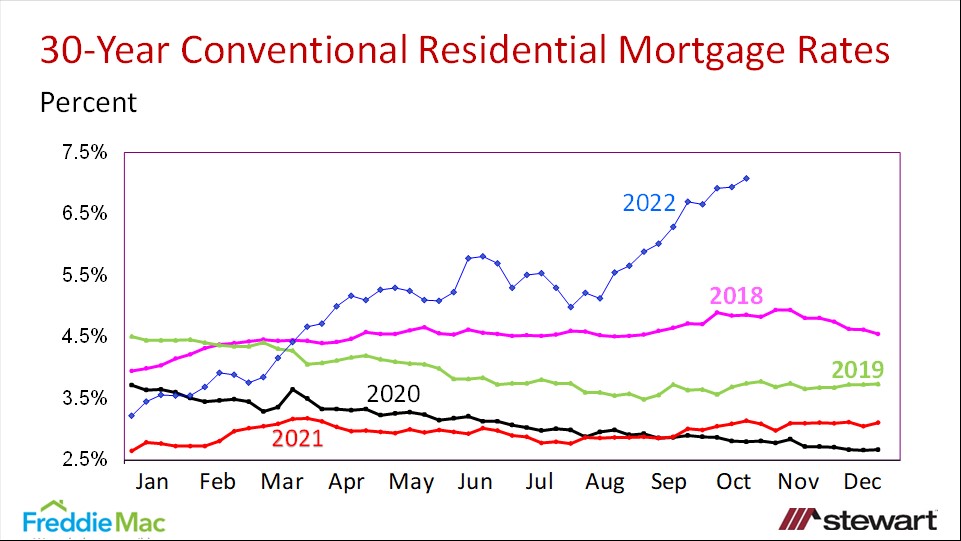
Interest Rate Expectations
Residential expectations are divergent when viewing Fannie Mae and the MBA’s expectations as shown in the tables below. The first table shows annual rates and the next quarterly. While the MBA sees annual rates changing little in 2023 (going from 5.3 percent to 5.4 percent), Fannie Mae is projecting a 110 basis point increase in annual rates rising from 5.3 percent in 2022 to 6.4 percent in 2023.
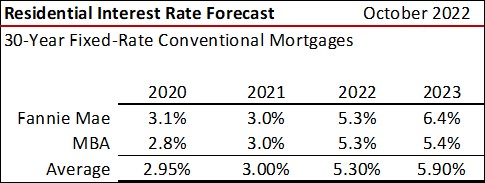
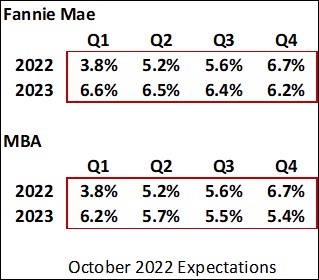
Monthly Principal & Interest Payments 2020 Vs 2023
We know what the typical principal & interest payment (P&I) was in 2020 for the median priced-home at the average annual interest rate. If the MBA is correct in their current 2023 forecast, the typical P&I payment will be 73.1 percent greater Vs 2020. If Fannie Mae is on target, the monthly P&I payment in 2023 will be up 85.0 percent. The gains are a function of changes in median price and interest rates.
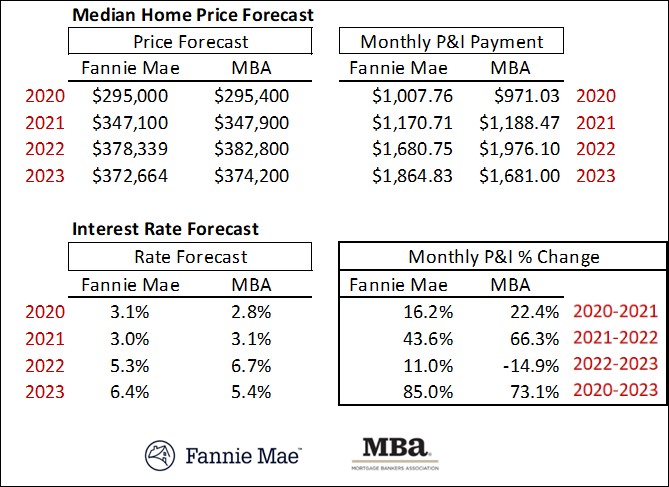
Existing Home Sales
Fannie Mae and MBA see declining existing home sales in 2023, but Fannie Mae forecasts just less than 4 million. If realized, 2023 would have the fewest number of existing home sales since 1995. Both Fannie Mae and the MBA forecast declining median prices, though the drop is minimal at an average 1.9 percent.
Existing Home Median Price Change Forecasts 2022 to 2023
-1.5% Fannie Mae
-2.2% MBA
0% Goldman Sachs
-10% to -15% FitchRatings
+1.3% Zillow – 12-months ending September
-5.5% Wells Fargo
+3.2% CoreLogic - -12 months ending August 2023
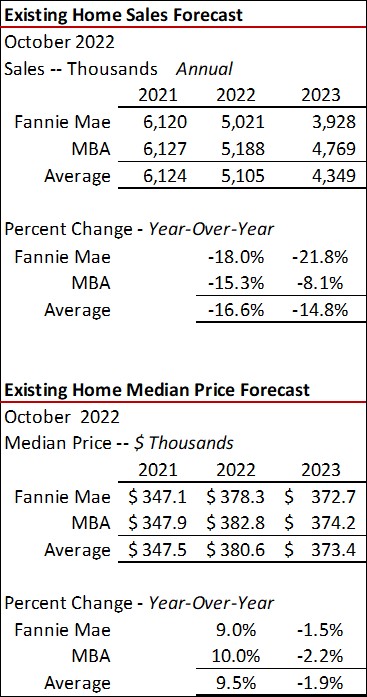
New Home Sales
Since 2002, there has been an average one new home sale for every 8.9 existing home closings. Both expect new home prices to be slightly down in 2023 (ranging from -0.3 percent to -1.5). They differ in the number of new home sales, however, with the MBA indicating a 1.9 percent gain and Fannie Mae a 12.6 percent decline.
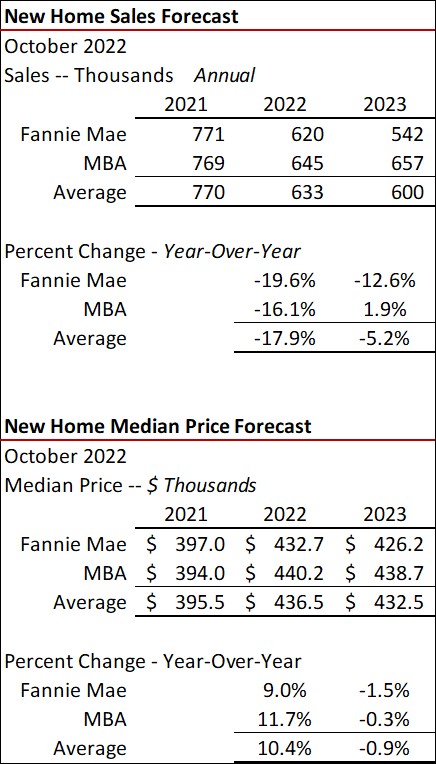
Residential Lending
Rising interest rates crushed refinance activity in 2022 compared to 2021 (down a projected 73.8 percent) and down another 23.5 percent to 44.1 percent in 2023. More than one-half of all residential mortgage lenders in business in 2021 are now out of a job in the mortgage industry with cuts yet to come.
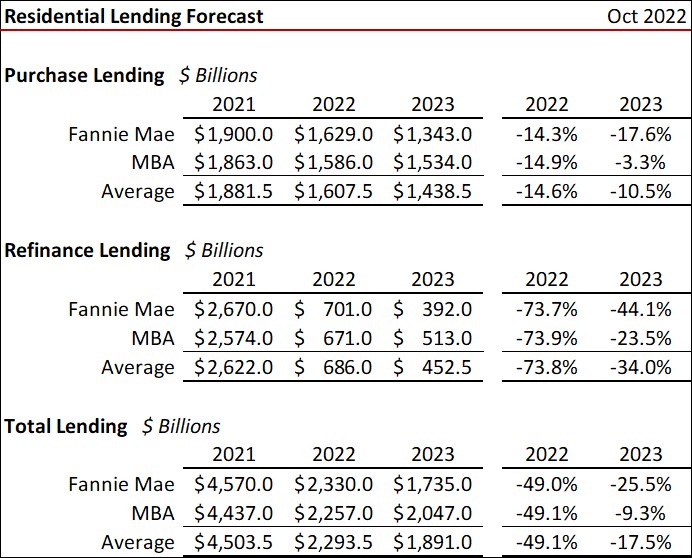
The chart below shows quarterly year-over-year lending changes for purchase and refinance activity. If correct, there is material pain still coming through the first two quarters of 2023 in the residential lending segment.
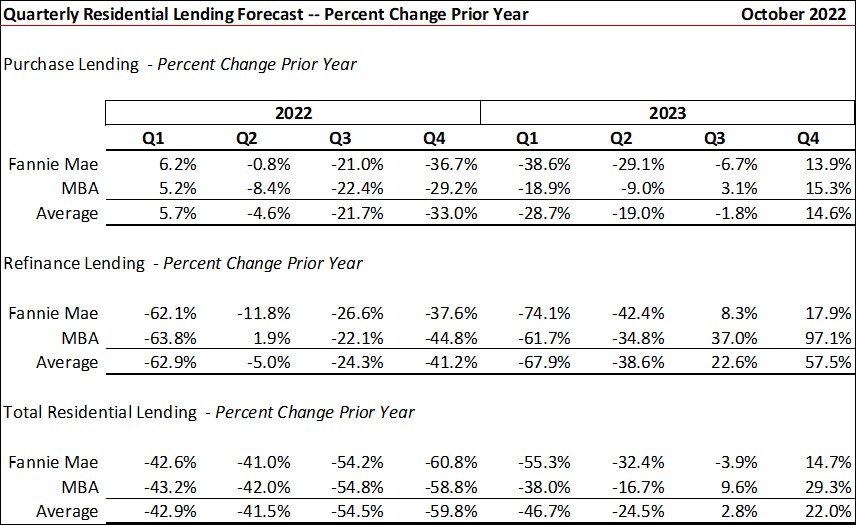
Can the outlook change? Yes, and it primarily is going to depend on interest rates, whether a material recession takes place, consumer confidence and inflation. The U.S. Congress Joint Economic Committee estimates that inflation is costing the typical household in the country $715 more per month to maintain their lifestyle compared to one year ago. Assuming Freddie Mac’s current 7.08 percent mortgage rate is reflective, the typical household lost a staggering $106,500 of loan capacity to buy a home assuming no change in income.
Pay attention to inflation and mortgage rates. Obviously the worse is yet to come.
